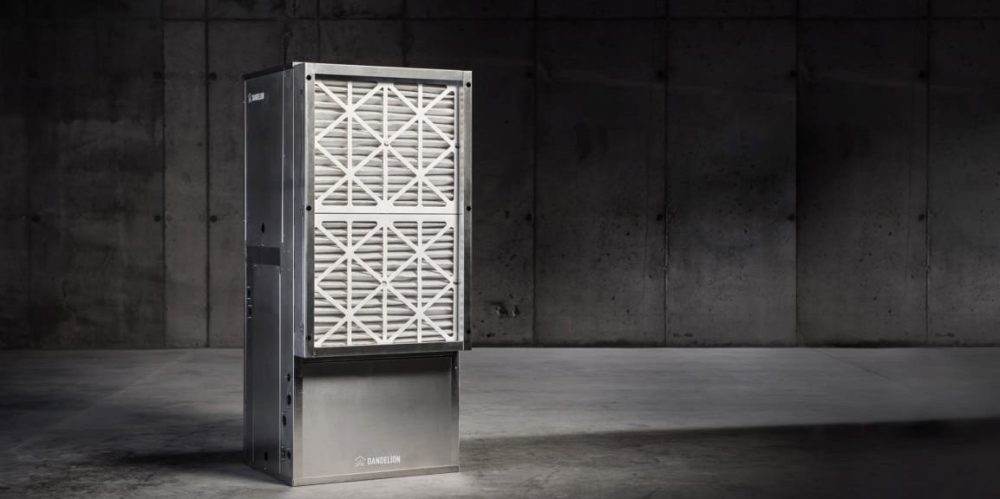
Kathy Hannun came to geothermal while at Alphabet’s Google X. In May 2017, she spun the company out and assumed the role of CEO of Dandelion Energy. She’s now in the role of president of the company, which allows her more free time, which means she can talk to us!
Hunnan spoke with Electrek‘s publisher Seth Weintraub and writer Michelle Lewis about why home geothermal systems are more affordable, convenient, and energy-efficient than anything else out there. At the same time, geothermal eliminates the fossil-fuel-based heating oil and gas systems currently in use.
Seth Weintraub: Your background is from tech-heavy Stanford Computer Engineering and Alphabet’s Google X. What innovation have you brought with you to the more traditional geothermal heating and cooling industry from your previous experiences?

Kathy Hannun: Geothermal had different categories of innovation that it needed in order to push the industry forward: business model, financing, and technology.
Typically, this industry operates with really small contractors who install a small number of custom systems. That makes things very expensive. So, the fact that [Dandelion] really focuses only on geothermal gives us a lot of cost advantage we can pass on to the customer.
We allow our homeowners to pay for the system upfront or with a loan that lasts for the lifetime of the system. It’s affordable and practical for a mainstream audience. There is opportunity, though, for further innovation.
The mission of the company is to figure out a solution so that there are no more barriers for people to switch [to geothermal].
One of the big shifts in selling to a mainstream audience is that they have to be less expensive than the alternative. We have to do everything we can to make the economics work well for the homeowner. (To learn more about whether Dandelion works for you, click here.)
SW: Dandelion moved into Connecticut after working in New York State. What made you go to Connecticut, and what are the incentives and the mix of fossil fuel energies they’re using?
KH: Connecticut was a very natural place for first expansion because it borders New York. So it was very easy to send our drilling crews right across the border. And there are similar incentives. In the near term, we’ll continue to expand according to those sorts of criteria.
Con Edison is partnered with Dandelion [in New York] and really promoted geothermal heat pumps to their natural gas customers because their natural gas system is constrained. So they provided incentives [for geothermal]. But I think if gas wasn’t constrained, then a gas company might see us as a competitor.
We’re seeing a policy movement against expansion of natural gas in the Northeast, because a lot of towns don’t want to continue to invest in that fossil infrastructure. And so it does present an opportunity for us.
Michelle Lewis: Could you possibly go to hot states for cooling?
Nevada, for example — not the first place you think of for geothermal, it’s very water constrained.
So they use a lot of cooling towers for their air conditioning, which evaporate water. But if you use geothermal, you would save a lot of water.
Seth Weintraub: You recently moved into the role of president from CEO. Has that allowed you to change your work?
KH: Dandelion is an operationally intensive business because we have many people selling many geothermal systems to many homes. I am a very product-focused person.
So I decided to hire Michael [Sachse] to become CEO so I could spend my time pushing our product and technology forward and looking at how to make geothermal increasingly cost-effective and mainstream. And I get to focus on that all the time now, which has been a really great change for me.
The transition that COVID has really started in the business world in general of making remote, distributed work more mainstream is very convenient for Dandelion, as we were going to have to figure out all those problems anyway.
SW: [Dandelion’s] model is a little like Solar City, which is now Tesla. Can you talk about the similarities in the way that you work? Tesla sells the solar battery system, and those kinds of people are probably good customers for geothermal solutions as well.
KH: Solar and [geothermal] are perfectly complementary products.
Your solar system makes your home electricity use renewable, and for many homes, especially in the Northeast, you don’t use electricity today to heat; you use a fuel like oil. By converting to geothermal, they’re able to use solar to run their geothermal heat pump.
So, I think we’ll see more solar systems working in tandem. And we as a company have relationships with solar companies, as early adopters for geothermal are already interested in solar and vice versa. And in future, there will be increasing coordination between those systems.
SW: You’re drilling a little bit differently than other geothermal companies. You go straight down. Why do you do that?
KH: You’re right, there are different ways to install the ground heat exchanger, also called the ground loop. And a lot of companies do it by excavating a large area, like for a [swimming] pool, for example. The reason we’ve standardized a vertical six-inch-diameter borehole is because many homes don’t have space for the horizontal pipe. And a lot of homeowners don’t really want their entire yard excavated.
It’s helpful to innovate on geothermal technology as a venture-backed startup with more resources. We prototyped and tested three different drilling approaches, and that’s just one example. It would have been very difficult outside of a place like Alphabet, where the resources exist purely for innovation.

ML: How long is a geothermal system’s lifespan? And what would customers expect to change when they switch from oil to geothermal?
KH: The heat pump in the house lasts about 20 to 25 years. The ground loop lasts essentially forever. So once you get the ground dug, that house will never have to use oil again. The cost of replacing the heat pump is like replacing a central air conditioner.
You have one heat pump that can run in one direction for heating and then the internal circuits reverse and it cools. So you don’t need a separate furnace or compressor outside your house. It’s quieter. A heat pump operates steadily and maintains it at the temperature you want. And because it’s not heating that air as high as a furnace does, the air doesn’t lose all of its moisture. You also have no combustion particulates so you don’t even need a carbon monoxide detector anymore. There’s no chance that you can accidentally poison yourself with a heat pump.
SW: I’m adamant about getting off fuel oil. What should homeowners like me expect when we contact Dandelion?
KH: Over time, Dandelion will increase the types of homes [we work with]. The reason that we’ve narrowed it to homes with existing ductwork throughout the house today is those are the simplest homes to serve with our product line. And so we’re really working on making the experience of those homes perfectly seamless so that we can have a very skilled solution.
When you have a product that you want to scale, it’s important that that product can be the same for many customers. But our mission is to decarbonize heating. We want to be able to serve all the homeowners that want to switch off of fossil fuels.
[It should be noted that Seth Weintraub’s New York home was eventually turned down by Dandelion.]
ML: What are the misconceptions about geothermal that you want to dispel?
KH: For example, the fear that it’s not going to heat someone’s house warmly enough or cool it enough. We’re lucky to have a large-enough customer base that can talk to prospective customers about the fact that it’s actually more comfortable than their system was before.
When people hear geothermal, sometimes they think, are we going down to the Earth’s core? And so we often have to explain, the sun shines on the earth every day and a lot of that heat hangs out in the shallow underground. And we’re collecting and concentrating that heat so that homeowners can use that to heat.
We ask homeowners at the beginning what temperatures they like their house to be. We just need to make sure that we put the right size unit in to accomplish that.
On a 95F day, it’ll still be 50F in the ground because the ground always stays at around 50 degrees in New York. It’s much more efficient to reject heat from the house into the ground than it is into the 95 degree air. Anything you can do with an air conditioner and cooling, you should be able to do much better with the geothermal system.
SW: Where does Dandelion ultimately want to get to?
KH: I would like to use Dandelion as a force to decarbonize. It’s going to be a very important thing to do if we’re going to be able to limit climate change. So I want Dandelion to put in heat pumps at as rapid a pace as they can, and also invest in moving the technology forward.
And it’s already the most cost-effective option to switch to renewable heating, and that has been hugely gratifying to see for me. How rapidly that adoption happens will be a function of the decisions that policymakers make. We don’t have the benefit of time.
Bonus question! SW: Is there a way to supercharge your growth?
We will be looking for capital to supercharge our growth. We have figured out our business model. We’re coming up to a really exciting time.
There are lots of investors that are looking at ways to get a return while still making progress on the climate problem. It’s not just because they know it’s the right thing to do ethically, but because they know it’s a smart thing to do financially.
All of our investors to date have been venture investors without a specific focus on the environment. But they were really interested because they see that the potential economically.
If you can align the economic incentive with the environmental incentives, you have the opportunity for massive impact. That’s really what attracted me to geothermal heat pumps to begin with. My job [with Alphabet] was to look for opportunities to create businesses that would have a positive impact.
And if it felt like a pretty uncommonly good opportunity to align everyone’s incentives, which is why I ended up pursuing it. I studied civil engineering and computer science. Never thought that I would have a career that combines those two things. But it worked out.
Thank you to Kathy Hunnan for talking with us. If you’d like to learn more about Dandelion Geothermal, click here.
Subscribe to Electrek on YouTube for exclusive videos and subscribe to the podcast.
Author: Michelle Lewis
Source: Electrek



